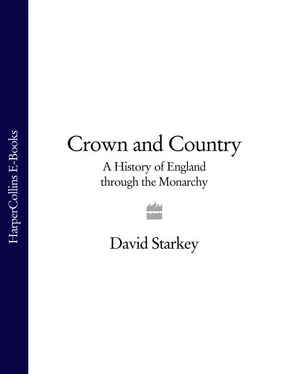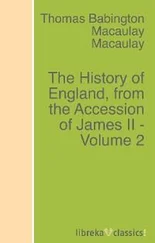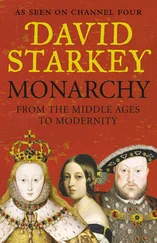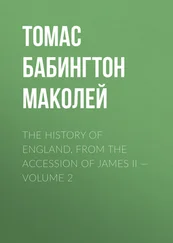Æthelbert, as soon as he was informed of Augustine’s arrival, ordered him to remain in quarantine on the Isle of Thanet, which was then cut off from the mainland by the Wantsum Channel. After a few days, the king decided on a meeting. So he crossed into Thanet and held his court there in the open air. This was to protect him from Augustine’s magical powers, which, the king and his advisers feared, might prove irresistible indoors. But, when he was summoned to the presence, Augustine employed instead the weapons of liturgical ceremony, which the Church had already polished to a fine art. Augustine entered the assembly robed and in procession, accompanied by his monks ‘bearing a silver cross for their banner, and an icon of Jesus (“the image of Our Lord painted on a board”) and singing the litany [in Latin]’.
Bede describes this entry as embodying ‘divine, not magical, virtue’. But the strangeness of it all – the dress, the symbols, the language and the music – must have been as potent as any spell to the Anglo-Saxons. It was a new way of doing things. And, as we shall see, it was to prove profoundly attractive.
Augustine then preached ‘the Word of Life’ to the king and his courtiers and his ‘interpreters of the nation of the Franks’ translated. Æthelbert heard them out courteously before making his reply. ‘Your words and promises are very fair’, the king said to his visitors, ‘but, as they are new to us, and of uncertain import, I cannot approve of them so far as to forsake that which I have so long followed with the whole English nation.’ But, he continued, he would welcome the missionaries. He would also allow them to ‘preach and gain as many as you can to your religion’.
Æthelbert was playing a subtle political game. He was well aware of the advantages which had accrued to the Franks after their conversion to Roman Christianity. But he needed to be convinced that it would work for him, for the political risks of conversion were enormous. So, in effect, he was inviting Augustine to market-test Christianity: there would be no Constantinian heroics of conversion; instead, Æthelbert would convert only when the people had shown it safe to do so.
Augustine got to work right away. The mission, with its formal preaching, teaching and services, was based in Bertha’s little church of St Martin’s, Canterbury. But equally effective in attracting converts, according to Bede, was the missionaries’ exemplary monastic life. The result was a mass baptism of 10,000 Kentish people at Christmas 597. Some historians take this to mean that Æthelbert himself must have converted already. But Gregory makes no mention of this fact in his report of the incident. Instead, it seems clear that Æthelbert held out for some years more. Finally in 600–1, Gregory vented his feelings at the continuing delay in a letter to Queen Bertha. She had done much, he had heard. But she could – and should – have done more: ‘you ought before now, as being truly a Christian, to have inclined the heart of our glorious son, your husband, by the good influence of your prudence, to follow, for the weal of his kingdom and of his own soul, the faith which you profess’.
Gregory’s is the earliest surviving letter to an English queen consort and the first picture of her role. It is a remarkably familiar one. She is pious and literate and her husband is expected – rather optimistically in Æthelbert’s case – to be putty in her hands. Gregory’s letter also gives a sense of Bertha’s place in the world, and, by extension, of England’s too. Naturally, the ‘world’, as Gregory saw it, was – despite all the vicissitudes of the city – resolutely Roman. ‘Your good deeds’, he assured Bertha, ‘are known, not only among the Romans … but also through divers places, and have even come to the ears of the most serene prince [the emperor] at Constantinople.’
Within a few months of Gregory’s letter to Bertha, Æthelbert was baptized, almost certainly at the hands of Augustine himself.
What had carried the day? True, the psychology of Augustine and Gregory in dealing with Æthelbert had been subtle. They had presented the Christian God as a great king, who would reward Æthelbert’s service in this world and the next, just as he, the bretwalda of England, rewarded his own faithful servants. But, finally, the key was probably political. For Christianity would enhance Æthelbert’s kingship with two things that were very attractive to a Dark Age ruler: Roman ideas about power and Roman ways of doing things. Like Rome, the Church used Latin. It had an elaborate system of law and administration, and it built in stone. Above all, the Roman Church was ruled by a monarch, the pope, who, like the emperors, claimed absolute and divinely ordained authority. The pope even used one of the imperial titles: supreme pontiff.
All this the Church made available to Æthelbert, now that he had converted to Christianity. The advantages for the king were obvious. One of the first things Æthelbert did after his conversion was to issue a Law Code, like Justinian and other Christian Roman emperors. But, though the form is Roman, the content of the Code is wholly Anglo-Saxon and merely sets down in writing the existing law of the folk in their own language, with the necessary adaptations to their new Christian status. Indeed, the Code may be the first document written in English and the story goes that Augustine himself had to devise additional new letters of the alphabet in order to write Anglo-Saxon down. And it is revered: at the top of the document, written in red, it reads: ‘These are the dooms [judgements] that King Æthelbert fixed in Augustine’s days.’
But could the Anglo-Saxon ideal of elective kingship survive these new trappings of divine and imperial authority and the power that went with them?
Over the next few years, the structure of the English Church was worked out in an exchange of letters between Gregory and Augustine. The English Church was to be self-governing under the pope. There were to be two provinces, each under a metropolitan or (as he was later known) archbishop: the northern based at York and the southern at London. Augustine himself was to be the first archbishop of the southern province with final authority over the whole English Church and (which became a point of bitter contention) over the surviving British bishops as well. The scheme was based partly on memories of the administration of later Roman Britain and partly on the current reality of the geopolitics of the Anglo-Saxons, who divided themselves into South- and Northumbrians (those living south and north of the River Humber). In the event, Augustine and his successors continued to be based at Canterbury. Otherwise, the lineaments of the scheme have survived and continue to the present.
Augustine died in c. 605 and Æthelbert a decade later in about 616. Both were buried in the splendid abbey, later known as St Augustine’s, which Augustine had founded after his mission outgrew St Martin’s. Augustine’s fellow missionaries and successors as archbishops were buried on one side of the church, and Æthelbert and Bertha and their successors as kings and queens of Kent on the other.
It was a symbolism of death to equal and outdo Sutton Hoo itself. It also spoke eloquently of the alliance of Church and king that, for a thousand years, would be one of the principal driving forces of English political life and practice.
III
The reigns of Æthelbert and Redwald marked the end of the domination of the south-east. Thereafter, the Anglo-Saxon balance of power swung away from the area of earlier settlement towards the north and west. Here, larger, newer kingdoms were being forged at the margins of Anglo-Saxon power: Northumbria in the north; Mercia in the Midlands and Wessex in the south-west. Each in turn was to dominate until finally, partly by accident and partly by design, a unified kingdom of Ængla Land (England) was created.
Читать дальше












